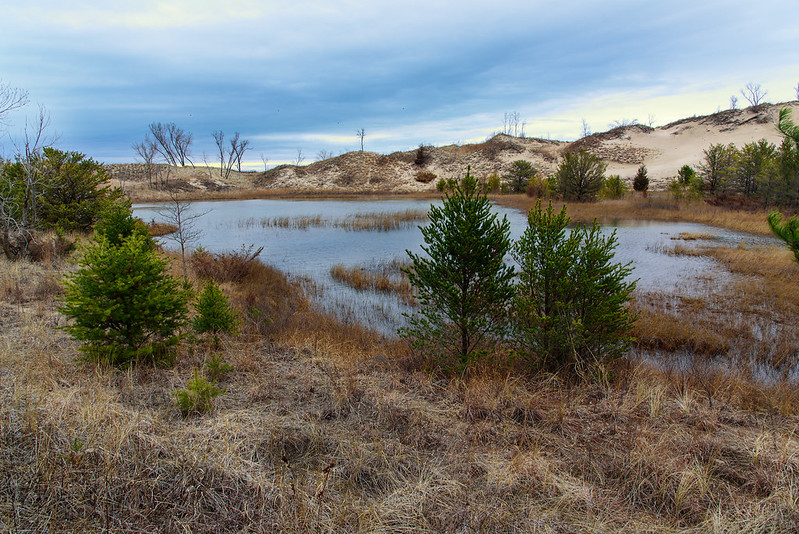 Nature and wildlife continue without pause at this peaceful interdunal pond in Northwest Indiana. The Covid-19 pandemic is touching almost everyone in some way, yet nature here is as beautiful as ever, unaffected by the chaos just miles away. Illinois is under a "Shelter in place" order to prevent the spread of the virus. Many other states are too, as well as several countries hit hard by the corona virus. Even though a shelter in place order is in affect, people may venture out for necessities such as groceries, medication, hardware, and even take-out food. More importantly, people may go on walks and hikes, providing they do so in a safe manner - not in groups and keeping a safe distance from others. Without this, I think people would feel the stay home order considerably more. I feel hiking in nature is a necessity. I was very happy to discover the Indiana Dunes National Park was still open for hiking. I mean, why not? The buildings and restrooms are all locked, and the welcome center is closed as well. So we brought a few snacks and drinks and headed out for some fresh air and exercise. While I am accustomed to hiking these trails alone, sometimes never seeing another visitor on winter hikes, I was surprised to see about six other people on this trip. I generally say hello to everyone I encounter on my hikes, but this day was a bit different. I still said hello, but the interaction between people was much more friendly than usual. I think seeing another person made them feel a bit more normal in these times, and yes, there's another person with the same idea of getting out of the house while they still can! Who knows how long this virus will keep us from our normal activities, but I will certainly continue hiking safely until I'm ill, or until ordered not to.
Nature and wildlife continue without pause at this peaceful interdunal pond in Northwest Indiana. The Covid-19 pandemic is touching almost everyone in some way, yet nature here is as beautiful as ever, unaffected by the chaos just miles away. Illinois is under a "Shelter in place" order to prevent the spread of the virus. Many other states are too, as well as several countries hit hard by the corona virus. Even though a shelter in place order is in affect, people may venture out for necessities such as groceries, medication, hardware, and even take-out food. More importantly, people may go on walks and hikes, providing they do so in a safe manner - not in groups and keeping a safe distance from others. Without this, I think people would feel the stay home order considerably more. I feel hiking in nature is a necessity. I was very happy to discover the Indiana Dunes National Park was still open for hiking. I mean, why not? The buildings and restrooms are all locked, and the welcome center is closed as well. So we brought a few snacks and drinks and headed out for some fresh air and exercise. While I am accustomed to hiking these trails alone, sometimes never seeing another visitor on winter hikes, I was surprised to see about six other people on this trip. I generally say hello to everyone I encounter on my hikes, but this day was a bit different. I still said hello, but the interaction between people was much more friendly than usual. I think seeing another person made them feel a bit more normal in these times, and yes, there's another person with the same idea of getting out of the house while they still can! Who knows how long this virus will keep us from our normal activities, but I will certainly continue hiking safely until I'm ill, or until ordered not to.
Calmness Near Chaos
 Nature and wildlife continue without pause at this peaceful interdunal pond in Northwest Indiana. The Covid-19 pandemic is touching almost everyone in some way, yet nature here is as beautiful as ever, unaffected by the chaos just miles away. Illinois is under a "Shelter in place" order to prevent the spread of the virus. Many other states are too, as well as several countries hit hard by the corona virus. Even though a shelter in place order is in affect, people may venture out for necessities such as groceries, medication, hardware, and even take-out food. More importantly, people may go on walks and hikes, providing they do so in a safe manner - not in groups and keeping a safe distance from others. Without this, I think people would feel the stay home order considerably more. I feel hiking in nature is a necessity. I was very happy to discover the Indiana Dunes National Park was still open for hiking. I mean, why not? The buildings and restrooms are all locked, and the welcome center is closed as well. So we brought a few snacks and drinks and headed out for some fresh air and exercise. While I am accustomed to hiking these trails alone, sometimes never seeing another visitor on winter hikes, I was surprised to see about six other people on this trip. I generally say hello to everyone I encounter on my hikes, but this day was a bit different. I still said hello, but the interaction between people was much more friendly than usual. I think seeing another person made them feel a bit more normal in these times, and yes, there's another person with the same idea of getting out of the house while they still can! Who knows how long this virus will keep us from our normal activities, but I will certainly continue hiking safely until I'm ill, or until ordered not to.
Nature and wildlife continue without pause at this peaceful interdunal pond in Northwest Indiana. The Covid-19 pandemic is touching almost everyone in some way, yet nature here is as beautiful as ever, unaffected by the chaos just miles away. Illinois is under a "Shelter in place" order to prevent the spread of the virus. Many other states are too, as well as several countries hit hard by the corona virus. Even though a shelter in place order is in affect, people may venture out for necessities such as groceries, medication, hardware, and even take-out food. More importantly, people may go on walks and hikes, providing they do so in a safe manner - not in groups and keeping a safe distance from others. Without this, I think people would feel the stay home order considerably more. I feel hiking in nature is a necessity. I was very happy to discover the Indiana Dunes National Park was still open for hiking. I mean, why not? The buildings and restrooms are all locked, and the welcome center is closed as well. So we brought a few snacks and drinks and headed out for some fresh air and exercise. While I am accustomed to hiking these trails alone, sometimes never seeing another visitor on winter hikes, I was surprised to see about six other people on this trip. I generally say hello to everyone I encounter on my hikes, but this day was a bit different. I still said hello, but the interaction between people was much more friendly than usual. I think seeing another person made them feel a bit more normal in these times, and yes, there's another person with the same idea of getting out of the house while they still can! Who knows how long this virus will keep us from our normal activities, but I will certainly continue hiking safely until I'm ill, or until ordered not to.
Through the Trees
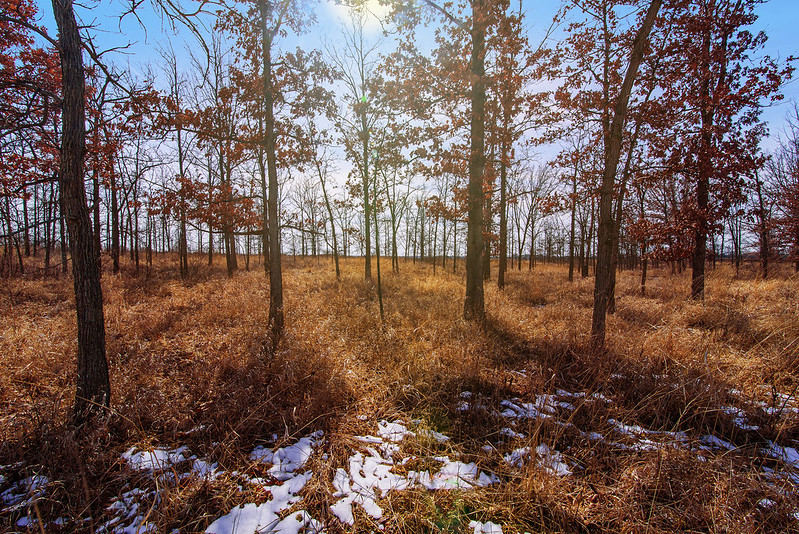
Hiking through the Orland Grassland on a warm, late winter afternoon showed some small remnants of winter, but the hope of spring was in the air. The golden hues of the sunlight on the matted down tall grass of the prairie reminded me that spring is only a few short days away. Some of these oak trees still had leaves left over from last year - it's pretty common to see this, but it still surprises me every time I see it. Richer green colors should begin to appear once the weather warms up; I've already heard the calls of some spring birds that arrived early. The Sandhill Cranes can be heard flying high above this grassland on their way to spend a day or two in northern Indiana (a well known stop on their long migration). Thousands congregate in marshes and plowed farm fields each March, and I make certain to witness their displays of dancing each spring. I'm hoping for a big turnout when I visit over the next couple of weeks.
Thawing Pond
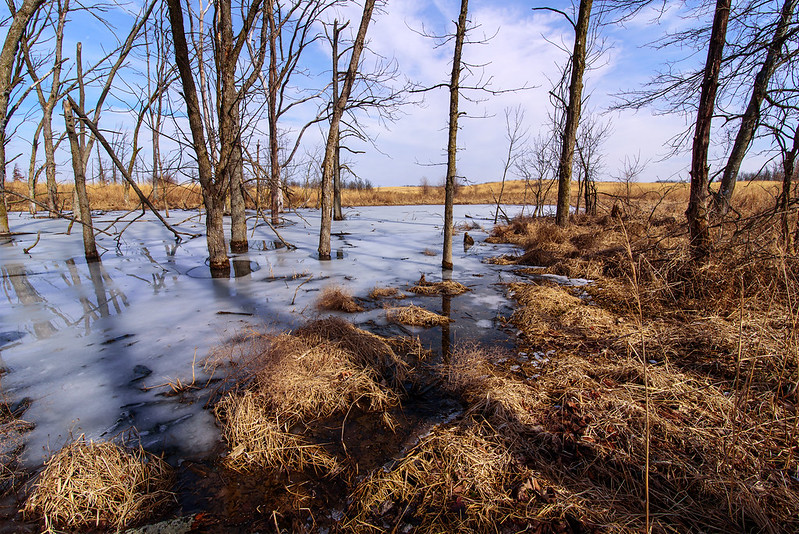
Some early spring-like weather came upon us on the first of March, perfect for a hike through the restored prairie. Following the removal of miles of clay drain tiles, this former farmland is returning to it's more natural state of a prairie and wetland. Small ponds dot the landscape, and they are just beginning to thaw in these warm temperatures.
The Orland Grassland has several miles of paved trails, and another few miles of mowed grass trails. I prefer the grass trails, but they are only open to hikers from October to May. Once the ground nesting birds return, these trails are off limits.
The grass trails take you away from most man-made things, although because of the proximity to cities, you never quite get away from everything. At times you can't see any homes or electrical towers in the distance, but you always hear the nearby highways. The grassland is almost two miles long by a mile wide, so plenty of green space, but you often see the reminders of civilization on the horizon.
Because of the recent thaw, the grass trails were quite wet and soggy, most likely the reason I was the only person on them. Suits me just fine.
Burning Through the Fog

Wildcat Den State Park is a lesser known park in eastern Iowa, just a few miles from the Mississippi River in Muscatine County. The trails here wind through some rock faces up to 75 feet tall, and through lush wooded terrain. A few of the rock faces are part of canyons which include some waterfalls - especially in wet weather.
Hiking these trails gives one the feeling of being very far removed from everyday life, yet civilization is just a few miles away. Several historic structures are on the property as well - in particular the Pine Creek Grist Mill. Built in 1848, the mill still operates for certain occasions in warmer months.
The sandstone cliffs here are typical of the driftless area of this part of the country. Driftless area were not affected by the last glaciation, so the rock remains as it was prior to the last ice age.
About a three hour drive from the Chicago area, Wildcat Den State Park is well worth the trip. And while you're visiting, take a quick ride north to Maquoketa Caves State Park for some small cave exploration.
The Foredune in Winter
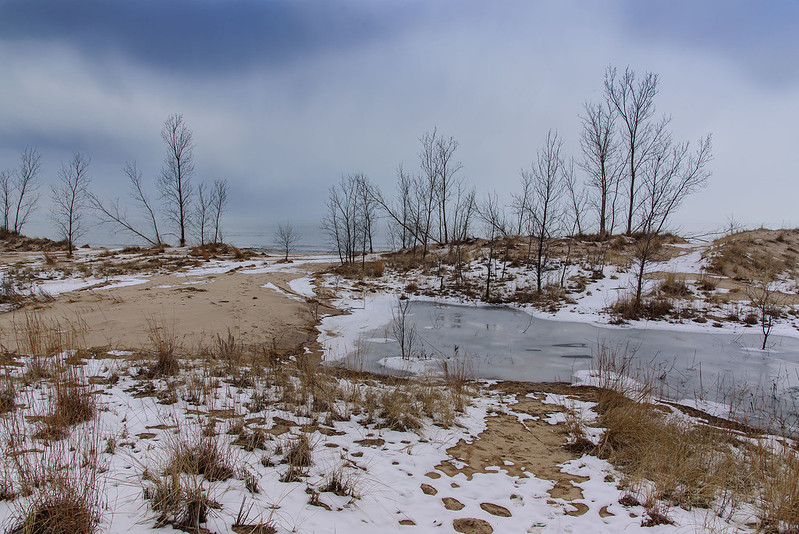
The first dune you encounter as you move from the body of water inland is called the foredune. Generally lower in height and filled with grasses, these can be interesting places to explore. With the recent high water levels of Lake Michigan, and constant erosion, many of these dunes have washed into the lake, leaving the taller dunes directly on the beach. But this one remains for now.
What's a bit more unique about this foredune is the interdunal pond directly behind it. This may not be unusual in a geologic sense, but at the Indiana Dunes National Park, I've only encountered a few.
In winter, these ponds freeze over and provide a contrast to the warmer looking marram grasses and sand of the surrounding dunes.
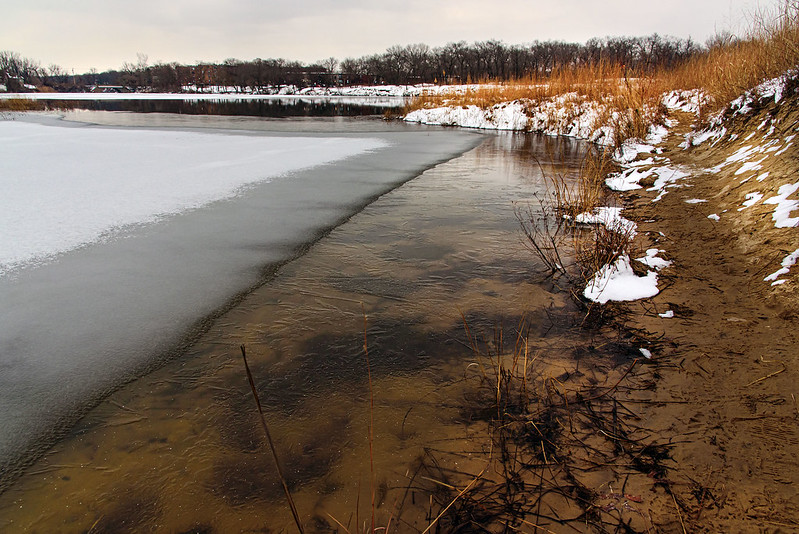
A bit away from the foredune, ice was just forming on the rivers and lakes inland. The change in textures can be seen here, from liquid water, to crystallizing water, to ice, then to snow covered ice. The crystal textures can be seen in the water if you look closely.
Golden Horizon
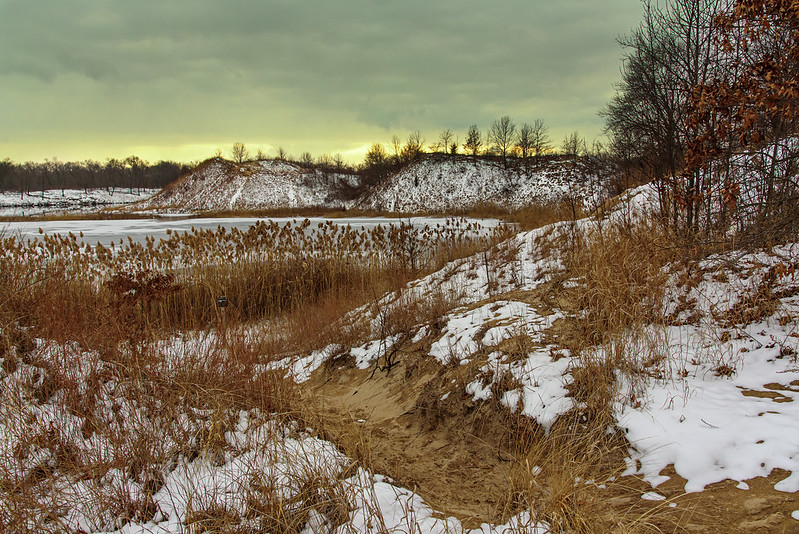
While changes in the landscape often take weeks, months, or even years, dramatic changes can occur quite quickly - especially when it comes to the sky and light. Hiking through Miller Woods takes a bit of time, and in the time it takes to traverse a dune or to travel from one dune to another, the mood of the sky can change drastically.
The thinner clouds were a few miles away, toward the horizon, so as the sun attempted to make an appearance, it was only able to penetrate the thin clouds far away. The horizon was bathed in golden light, making the hike to the beach a bit more magical.
Warm Winter Light

People often talk about "fire and ice" in photography - a warm color in a photo of a very cold, winter subject. While I can't really say I seek out photos like that, they do have a certain appeal. Every once in a while I will encounter a time when the cloudy sky opens up for a while allowing the golden light of the sun to highlight the clouds, and this was one of those days.
The yellow sky was quite a bit in the distance, and seemed it had little chance of heading toward us to illuminate the entire landscape, but there was just enough color at this moment to make the already interesting environment a bit more appealing.
This photo was taken on a hike through Miller Woods, part of the Indiana Dunes National Lakeshore in northwest Indiana. Several trails wind through this hilly oak savanna, making the two mile trek to Lake Michigan many more miles long if you explore them all. The landscape is dotted with dozens of small ponds between the hills of the dunes. It's a surprise this land has lasted this long without being taken over by the industry that surrounds it. Steel mills, railroads, and other heavy industry have taken their toll on the dunes of Indiana, but this was never really touched. The steel industry owned the land and ran several railroad tracks through it, but most of it remained rare oak savanna.
Thanks the the park service, this area was set aside for preservation, and it can be visited today.
Winter in the Oak Savanna

The trails wind through the snow covered oak savanna of Miller Woods in early February. An odd year with very little snow, and relatively warm temperatures (for a Midwest winter) kept the woods looking brown and boring, so this snowfall was a welcome site.
The trails wind for miles through these rolling woods, up and down and around dunes, hills, and dozens of interdunal ponds and wetlands. This area offers great sights in every season, and winter is no exception. I was hoping for clear skies and dark blue liquid ponds, but the cold temperatures the days prior to my visit turned the ponds to ice. The ice was very thin, but perfect for throwing stones onto it to make the metallic and otherworldly sounds as the stones skip along the ice. This only happens when the ice is just forming, and once the ice thickens, it no longer rings with these sounds.
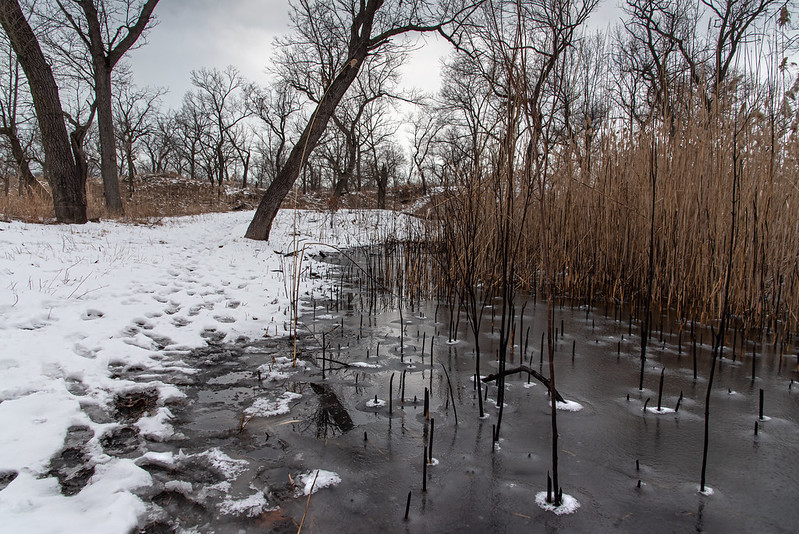
These first days of ice can be quite interesting, especially in areas that border the water. Tall grass, weeds, and other plants poke through the thin ice, and often form unusual shapes and patterns in the ice. These patterns can be fleeting, only lasting a few hours until the ice completely freezes.
Snowflakes
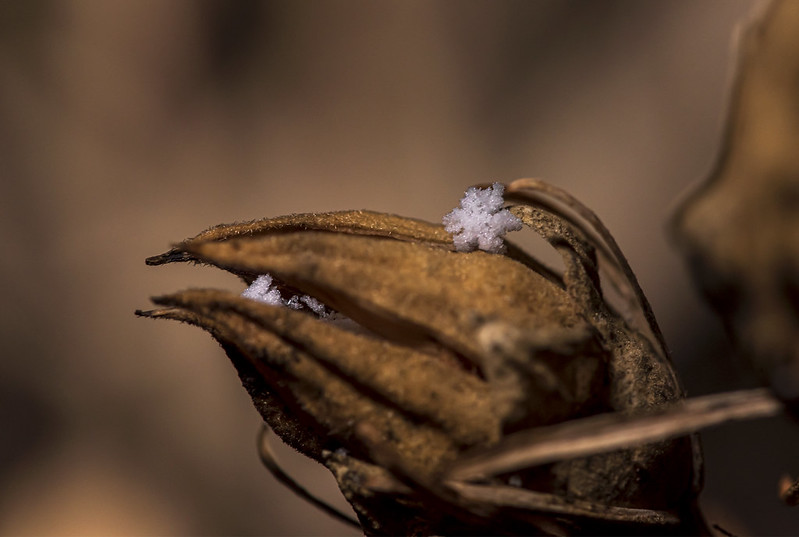
A quick look around the yard just after a snowstorm yielded some interesting snowflake configurations, but the warming temperatures and winds quickly degraded the intricate shapes of most snowflakes. The warm air began to make the crystal structures turn bloated, yet a few snowflakes kept some of their shapes.

Probably less than 1/2 inch, this tiny snow bridge was created by a bunch of snowflakes gathering together. Again, the warm temperatures quickly began melting the intricate crystals.
Transitions
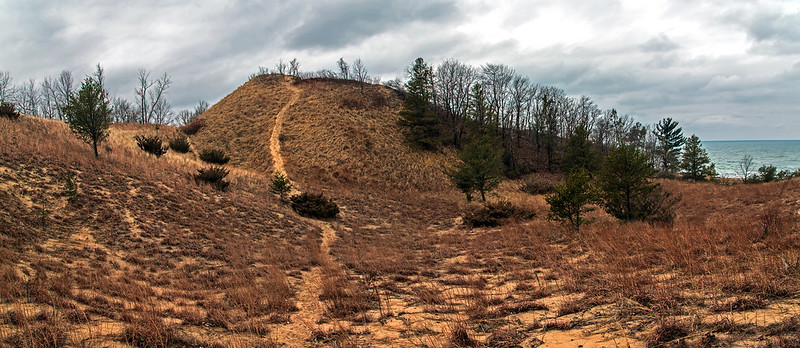
This marks the 14th anniversary of my blog. It's hard to believe it's been that long.
Generally at this time of year, the dunes are covered in snow and ice, but this winter has so far been different. The dunes are brown and seemingly dull- until you look a bit closer. In the warmer months, leaves fill the trees and block a lot of the features of the dunes themselves. Here in the photo above, you can see the transition from Lake Michigan to the wooded dunes, then to the grassy dunes. The leaf-covered ground is brown and grass-less under the trees, and the transition to the grassy area is quite abrupt. The trails are also easier to see now, as are some of the low growing plants and shrubs. There hasn't been a time I've visited this trail when I haven't discovered something new or different; and I've been hiking this dozens of times each year. Some of the grand things don't change, but if you pay attention, things change week to week all year long.
 Once we climbed the first series of dunes, we headed down into the valley, then up again on the taller dunes. Looking back, we can see the rolling dunes we traversed - hill after hill after hill, some small, others quite challenging. Carrying my usual 40 pounds of camera gear on my back, and a tripod in one had, climbing some of these trails can be difficult, especially those that pass close to shrubs and trees. I tend to get caught up on every possible branch. Winter hiking can be a bit uncomfortable here. There are even transitions in temperature and wind. On the unprotected beach, the wind can go right through you, while in the valley between dunes, there is little or no wind. Dressing in layers certainly helps, you can keep warm while on the beach and remove some layers when in the protected areas where it gets warm. You just need to remember the old saying, warm to start, cold to finish; cold to start, warm to finish. Start off being a bit cool and try to keep from sweating, then if you're not sweating, you'll stay warm for the walk back. It's very uncomfortable on the hike back if you stay so warm at first you begin perspiring. Still, it's well worth the time to hike the dunes in winter - even if you freeze on the way back.
Once we climbed the first series of dunes, we headed down into the valley, then up again on the taller dunes. Looking back, we can see the rolling dunes we traversed - hill after hill after hill, some small, others quite challenging. Carrying my usual 40 pounds of camera gear on my back, and a tripod in one had, climbing some of these trails can be difficult, especially those that pass close to shrubs and trees. I tend to get caught up on every possible branch. Winter hiking can be a bit uncomfortable here. There are even transitions in temperature and wind. On the unprotected beach, the wind can go right through you, while in the valley between dunes, there is little or no wind. Dressing in layers certainly helps, you can keep warm while on the beach and remove some layers when in the protected areas where it gets warm. You just need to remember the old saying, warm to start, cold to finish; cold to start, warm to finish. Start off being a bit cool and try to keep from sweating, then if you're not sweating, you'll stay warm for the walk back. It's very uncomfortable on the hike back if you stay so warm at first you begin perspiring. Still, it's well worth the time to hike the dunes in winter - even if you freeze on the way back.
The Seven Pillars of The Mississinewa
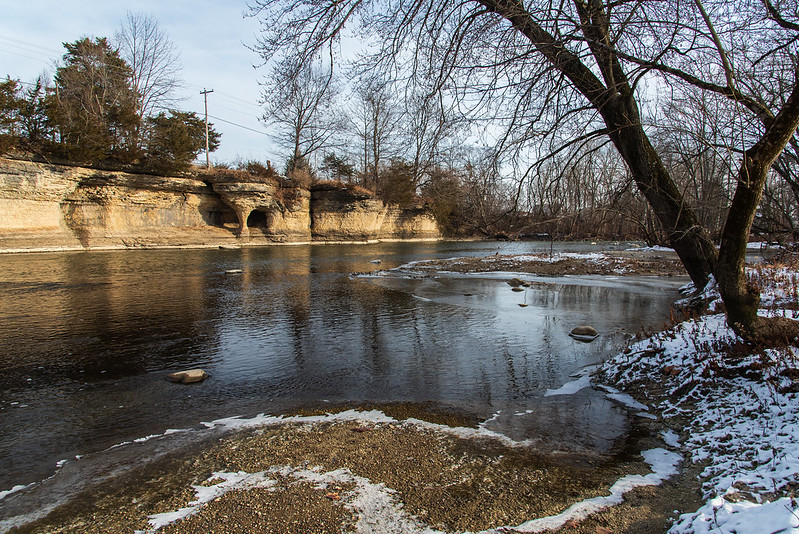 A sacred gathering place for the Miami Indians in years past, the Seven Pillars of the Mississinewa lie on the north bank of the Mississinewa River. The 25 foot tall limestone formation was carved by wind and water over thousands of years. The "rooms" created by erosion within the rock face were used by The Miami Indian Council for meetings and other activities for generations.
A sacred gathering place for the Miami Indians in years past, the Seven Pillars of the Mississinewa lie on the north bank of the Mississinewa River. The 25 foot tall limestone formation was carved by wind and water over thousands of years. The "rooms" created by erosion within the rock face were used by The Miami Indian Council for meetings and other activities for generations.  One of Indiana's best kept secrets, the Pillars of Mississinewa are owned by the Acres Land Trust along with many acres of land directly across the river where the Pillars can be easily viewed. A 1.8 mile moderately strenuous trail winds through the hilly, wooded preserve where beech and maple trees flourish.
One of Indiana's best kept secrets, the Pillars of Mississinewa are owned by the Acres Land Trust along with many acres of land directly across the river where the Pillars can be easily viewed. A 1.8 mile moderately strenuous trail winds through the hilly, wooded preserve where beech and maple trees flourish. 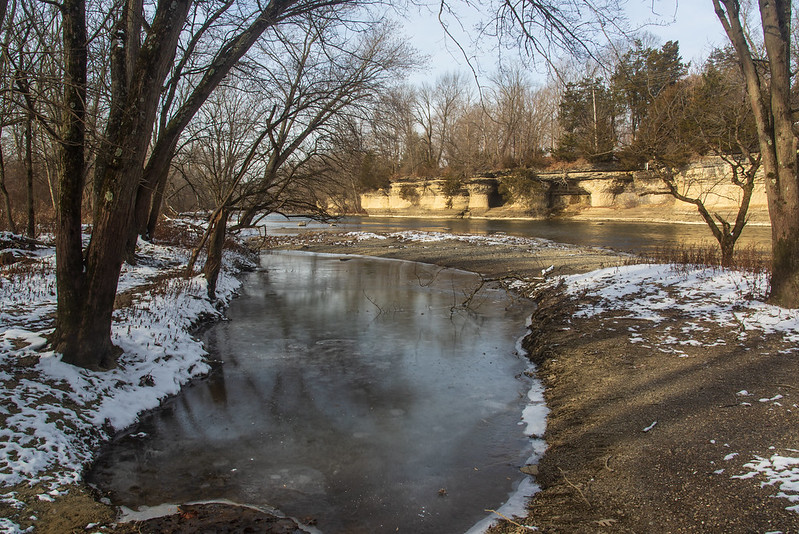 A feeling of calm was in the air when visiting this site. I wonder how many tribal meetings and important events took place here over the years. The Miami Indians still gather here today.
A feeling of calm was in the air when visiting this site. I wonder how many tribal meetings and important events took place here over the years. The Miami Indians still gather here today.
The Ladders
 While hiking trail three in Turkey Run State Park, one must use "The Ladders" - large wooden ladders set up to assist with some drastic elevation changes within the canyon. While not too precarious, the ladders do create a small bottleneck for visitors. It takes a bit of work to turn your back to the drop-off and grab the ladder to descend to the canyon floor - especially when you have 40 pounds of camera gear on your back, a camera and tripod in one hand, and the ladder is icy.
While hiking trail three in Turkey Run State Park, one must use "The Ladders" - large wooden ladders set up to assist with some drastic elevation changes within the canyon. While not too precarious, the ladders do create a small bottleneck for visitors. It takes a bit of work to turn your back to the drop-off and grab the ladder to descend to the canyon floor - especially when you have 40 pounds of camera gear on your back, a camera and tripod in one hand, and the ladder is icy.  On one visit, people were backed up on the top and the bottom of the canyon, waiting to use the ladders. One at a time, people climbed or descended the ladders. While we waited our turn at the top of the canyon, a person in my group backed up just a bit too far and slid down the side of the canyon. Luckily, he only fell about 6 feet to a ledge, but the ledge had a pool of water about two feet deep. Wet from the knees down, he continued to hike the rest of the day. That could have been a disaster if he was standing a few feet left or right. Each time I visit and hike this trail, I'm grateful the park did not build stairs in this area. The ladders keep this part of the trail a bit more rustic, and make for a more strenuous and interesting hike.
On one visit, people were backed up on the top and the bottom of the canyon, waiting to use the ladders. One at a time, people climbed or descended the ladders. While we waited our turn at the top of the canyon, a person in my group backed up just a bit too far and slid down the side of the canyon. Luckily, he only fell about 6 feet to a ledge, but the ledge had a pool of water about two feet deep. Wet from the knees down, he continued to hike the rest of the day. That could have been a disaster if he was standing a few feet left or right. Each time I visit and hike this trail, I'm grateful the park did not build stairs in this area. The ladders keep this part of the trail a bit more rustic, and make for a more strenuous and interesting hike.
Ice in the Punch Bowl
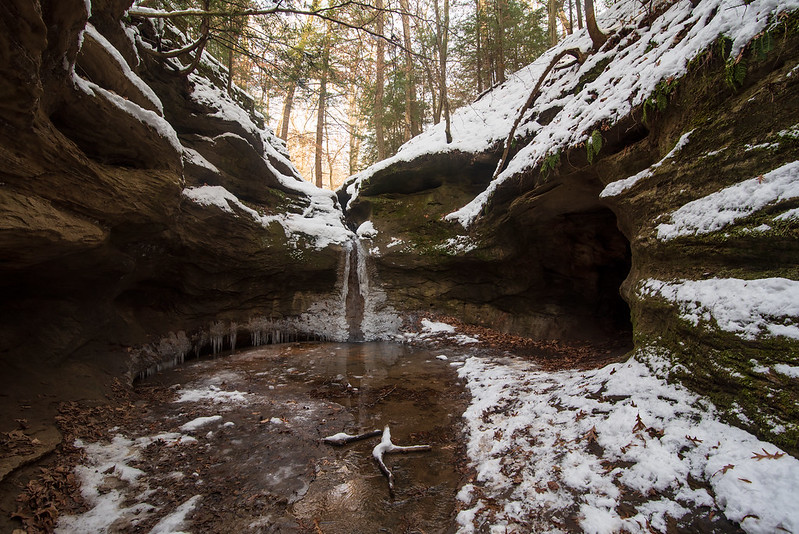 Winter temperatures created a bit of ice along the edges of the waterfall called the Punch Bowl in Parke County Indiana's Turkey Run State Park. This feature is located just after navigating a tight walled canyon where you either need to hike through a narrow stream, or climb up the side of the canyon wall using some carved hand and foot holds. While not overly difficult, it does offer a bit of a challenge while hiking. Located on a short branch trail, the punch bowl is a narrow waterfall approximately 15 feet tall that flows into a small pool at the bottom of the canyon. Generally this fall is running throughout the year and varies from a trickle to a full flow, so it's a dependable waterfall to freeze during the winter months.
Winter temperatures created a bit of ice along the edges of the waterfall called the Punch Bowl in Parke County Indiana's Turkey Run State Park. This feature is located just after navigating a tight walled canyon where you either need to hike through a narrow stream, or climb up the side of the canyon wall using some carved hand and foot holds. While not overly difficult, it does offer a bit of a challenge while hiking. Located on a short branch trail, the punch bowl is a narrow waterfall approximately 15 feet tall that flows into a small pool at the bottom of the canyon. Generally this fall is running throughout the year and varies from a trickle to a full flow, so it's a dependable waterfall to freeze during the winter months. 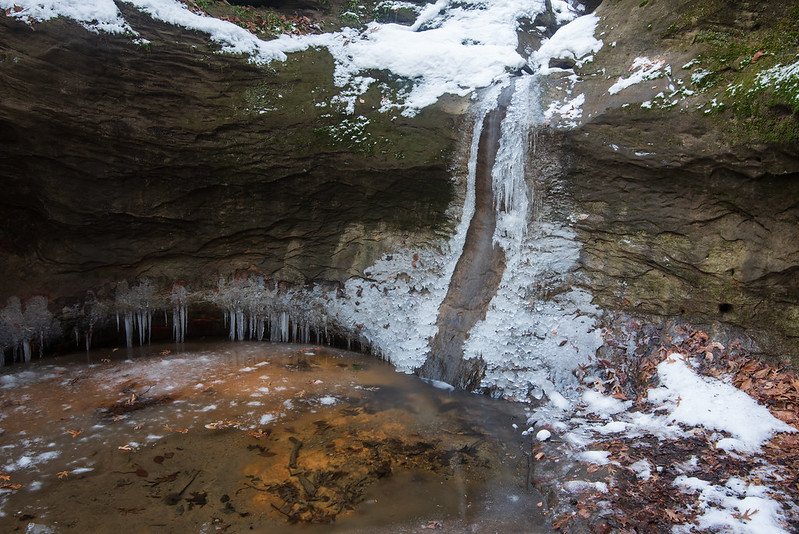 In warmer times, we enjoy a short additional hike up to the top of the Punch Bowl's waterfall. The small stream meanders through a series of turns and potholes before cascading down to the Punch Bowl, and it's an interesting and mesmerizing flow of water.
In warmer times, we enjoy a short additional hike up to the top of the Punch Bowl's waterfall. The small stream meanders through a series of turns and potholes before cascading down to the Punch Bowl, and it's an interesting and mesmerizing flow of water. 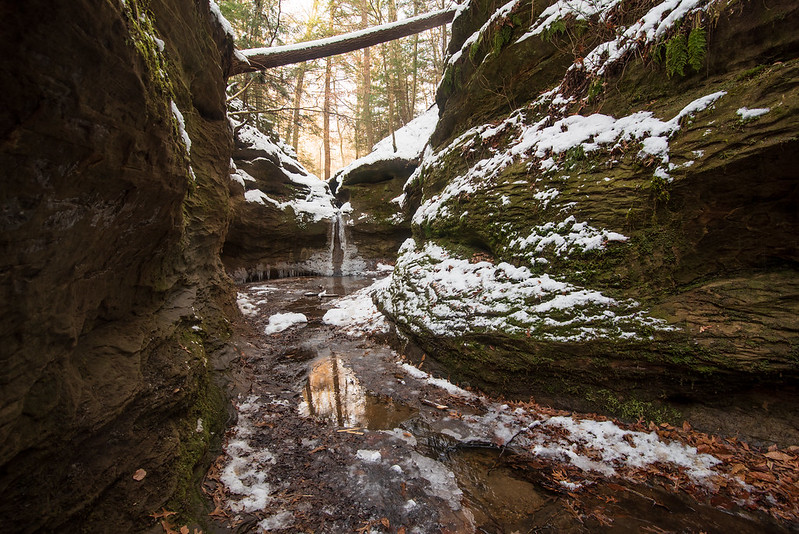
Squeezing Through the Canyon
 Immediately after climbing the small waterfall on trail 3, the canyon narrows. Depending upon the amount of recent rainfall, the stream could be a bit too deep to walk through (or in cold weather, even 3 inches of water is too much), so small stairs and hand-holds have been carved into the canyon walls. These "stairs" are about six inches wide and four inches deep, and barely have enough room for the tips of your shoes, but they are handy if you wish to keep your feet dry. We decided to stay on the ground and risk getting our feet wet because the recent snowfall made the canyon walls and "stairs" a bit too slippery. When the park is crowded this is usually a bottle neck as people wait their turn to navigate the small carved stairs.
Immediately after climbing the small waterfall on trail 3, the canyon narrows. Depending upon the amount of recent rainfall, the stream could be a bit too deep to walk through (or in cold weather, even 3 inches of water is too much), so small stairs and hand-holds have been carved into the canyon walls. These "stairs" are about six inches wide and four inches deep, and barely have enough room for the tips of your shoes, but they are handy if you wish to keep your feet dry. We decided to stay on the ground and risk getting our feet wet because the recent snowfall made the canyon walls and "stairs" a bit too slippery. When the park is crowded this is usually a bottle neck as people wait their turn to navigate the small carved stairs.  Soon after these two tight areas of the canyon, you reach the turn toward the Punch Bowl, a small waterfall with some very interesting canyon features. Heading forward, the canyon begins to open up, and with the person walking along the trail, you get the idea of just how large this part of the canyon is.
Soon after these two tight areas of the canyon, you reach the turn toward the Punch Bowl, a small waterfall with some very interesting canyon features. Heading forward, the canyon begins to open up, and with the person walking along the trail, you get the idea of just how large this part of the canyon is.
The Last Light of the Day
 With the short days of Fall and Winter, we found ourselves in the canyons of Turkey Run State Park late in the day, and after sunset. The park was open until 11 PM, but signs warned visitors to return to the suspension bridge before dark. I imagine it can be quite difficult to find your way around the canyons in the dark. Our pace increased a bit as we noticed the last of the sunlight hitting the treetops. Trail 3 brings visitors through deep canyons, narrows, and up on the surface through dense woods, so it has a bit of everything - even ladders to climb.
With the short days of Fall and Winter, we found ourselves in the canyons of Turkey Run State Park late in the day, and after sunset. The park was open until 11 PM, but signs warned visitors to return to the suspension bridge before dark. I imagine it can be quite difficult to find your way around the canyons in the dark. Our pace increased a bit as we noticed the last of the sunlight hitting the treetops. Trail 3 brings visitors through deep canyons, narrows, and up on the surface through dense woods, so it has a bit of everything - even ladders to climb. 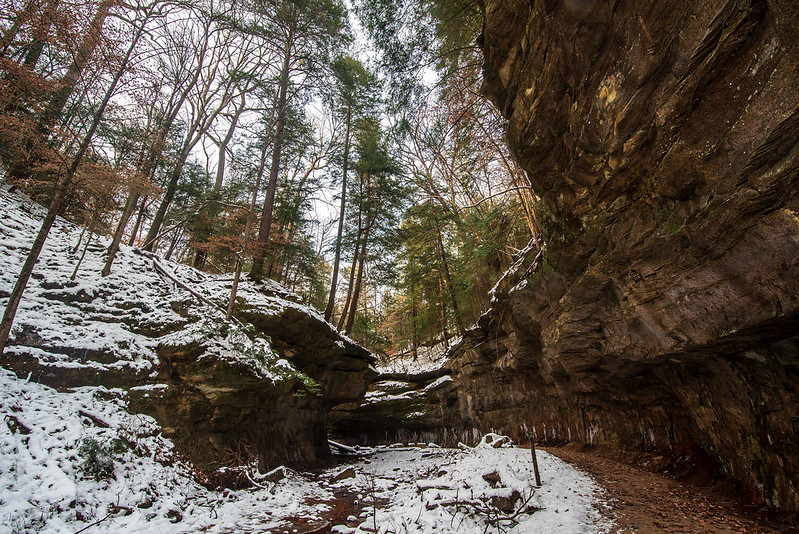 The recent snowfall added a pretty contrast to the dark sandstone canyon and the tall trees. The low temperatures froze the ground water seeping through the walls of the canyons, turning it to decorative icicles all along the trail. This part of the trail takes you up a small waterfall into a narrow canyon. You need to walk through the shallow, flowing stream, and on this cold day, the edges of the stream were icy, making the trek up the waterfall a bit difficult. I found it best to walk through the water rather than try to keep out of it, at least the stream bed wasn't icy and dangerous.
The recent snowfall added a pretty contrast to the dark sandstone canyon and the tall trees. The low temperatures froze the ground water seeping through the walls of the canyons, turning it to decorative icicles all along the trail. This part of the trail takes you up a small waterfall into a narrow canyon. You need to walk through the shallow, flowing stream, and on this cold day, the edges of the stream were icy, making the trek up the waterfall a bit difficult. I found it best to walk through the water rather than try to keep out of it, at least the stream bed wasn't icy and dangerous.
Wedge Rock in Winter
 The first prominent feature along Turkey Run's trail 3 is the famous Wedge Rock, a large chunk of rock that fell away from the canyon wall long ago. This rock is much larger than it looks, allowing hikers to walk beneath, and until recently, they were "able" to climb up to the top to take in the view of the entire canyon. On this visit to the park, we noticed a few new fences keeping people away from the back of Wedge Rock. In summer, this trail is lush with ferns, moss, and the trees above, and it stays well below the outside temperature, making the hike through this area very comfortable, and almost otherworldly. On this day in December, the temperatures were above normal, so it was difficult to determine if the opposite happens, if the temperature is warmer than the rest of the park.
The first prominent feature along Turkey Run's trail 3 is the famous Wedge Rock, a large chunk of rock that fell away from the canyon wall long ago. This rock is much larger than it looks, allowing hikers to walk beneath, and until recently, they were "able" to climb up to the top to take in the view of the entire canyon. On this visit to the park, we noticed a few new fences keeping people away from the back of Wedge Rock. In summer, this trail is lush with ferns, moss, and the trees above, and it stays well below the outside temperature, making the hike through this area very comfortable, and almost otherworldly. On this day in December, the temperatures were above normal, so it was difficult to determine if the opposite happens, if the temperature is warmer than the rest of the park.  From this angle, Wedge Rock appears so small in contrast to the canyon walls, and the towering tulip poplar trees on top of the canyon. Usually there are plenty of visitors on this trail, helping to give the formations scale, but on this day, we encountered only three other people on our three hour hike. This is another great benefit of visiting this park in winter, it's not crowded, and the snow and ice bring a whole new look to the landscape. When visiting in winter - even if the snow melts, wear ice cleats. The sun doesn't make it down to the canyon floor, so the packed snow and ice remain in place for quite a while, and some areas of the icy trail could lead to dangerous falls.
From this angle, Wedge Rock appears so small in contrast to the canyon walls, and the towering tulip poplar trees on top of the canyon. Usually there are plenty of visitors on this trail, helping to give the formations scale, but on this day, we encountered only three other people on our three hour hike. This is another great benefit of visiting this park in winter, it's not crowded, and the snow and ice bring a whole new look to the landscape. When visiting in winter - even if the snow melts, wear ice cleats. The sun doesn't make it down to the canyon floor, so the packed snow and ice remain in place for quite a while, and some areas of the icy trail could lead to dangerous falls.
Frozen Narrows
 The Narrows Covered Bridge spans the frozen Sugar Creek which runs through Indiana's Turkey Run State Park. It spans a narrow spot in the creek, and seems to collect quite a bit of ice in the early winter. I estimate 5 to 6 inches of snow fell on the park last week, and on our visit, the snow was still looking fresh. I think the cold weather keeps most visitors away from parks. It was easy to see where the visitors roamed by their footprints. In high traffic areas, the snow had already turned to hard, slippery ice, so it might have been best for us to bring our ice cleats, but we managed fine without them. I wouldn't go without them on any future visits this winter - it's only going to get worse.
The Narrows Covered Bridge spans the frozen Sugar Creek which runs through Indiana's Turkey Run State Park. It spans a narrow spot in the creek, and seems to collect quite a bit of ice in the early winter. I estimate 5 to 6 inches of snow fell on the park last week, and on our visit, the snow was still looking fresh. I think the cold weather keeps most visitors away from parks. It was easy to see where the visitors roamed by their footprints. In high traffic areas, the snow had already turned to hard, slippery ice, so it might have been best for us to bring our ice cleats, but we managed fine without them. I wouldn't go without them on any future visits this winter - it's only going to get worse. 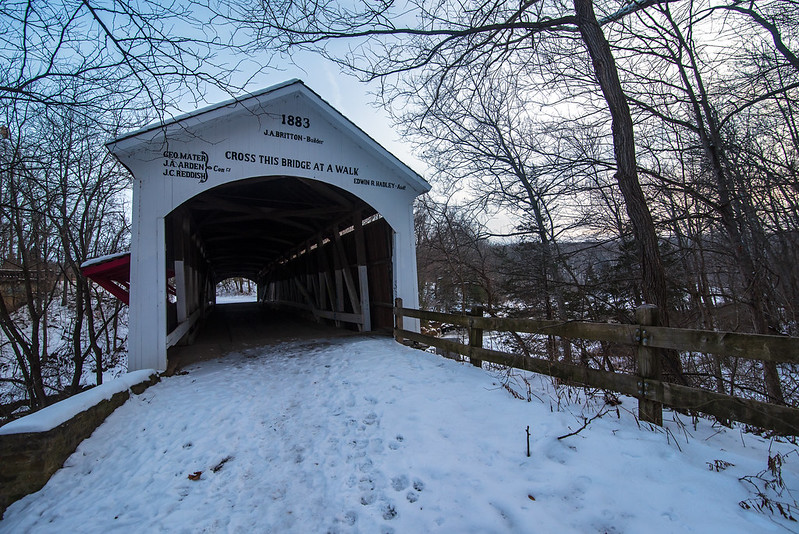 Built in 1883 by J. Britton, a popular bridge builder in this part of the country, the bridge has stood the test of time. Located in Parke County, Indiana, this is one of 31 covered bridges in the county - far more than the famous Madison County of movie fame (which has only 6). This is certainly the place to visit if you wish to see beautiful covered bridges - they even have an annual covered bridge festival in October.
Built in 1883 by J. Britton, a popular bridge builder in this part of the country, the bridge has stood the test of time. Located in Parke County, Indiana, this is one of 31 covered bridges in the county - far more than the famous Madison County of movie fame (which has only 6). This is certainly the place to visit if you wish to see beautiful covered bridges - they even have an annual covered bridge festival in October.  The park has so much to see in addition to the covered bridges. Canyons, waterfalls, woods, hiking, and even a beautiful inn for dining and lodging.
The park has so much to see in addition to the covered bridges. Canyons, waterfalls, woods, hiking, and even a beautiful inn for dining and lodging.
The Chellberg Farm
 While hiking the colorful trails of the Chellberg Farm, I headed toward the old farmhouse and barn. These building are open from time to time, to demonstrate farm life of the 1800's. In the past two years, the barn and fields have been the home to a few farm animals including two horses. As I approached the barn, the horses immediately came outside to greet me. I stood only a foot or two away from the fence, and they walked up to me. I tried to put a few feet between us so I could capture some photos, but they kept following me, staying right with me. I spent a little time with them, then continued on my way to the other side of the pasture. From there, I was able to capture some photos of the horses from a distance. Of course, this horse noticed me right away, then began heading toward me again.
While hiking the colorful trails of the Chellberg Farm, I headed toward the old farmhouse and barn. These building are open from time to time, to demonstrate farm life of the 1800's. In the past two years, the barn and fields have been the home to a few farm animals including two horses. As I approached the barn, the horses immediately came outside to greet me. I stood only a foot or two away from the fence, and they walked up to me. I tried to put a few feet between us so I could capture some photos, but they kept following me, staying right with me. I spent a little time with them, then continued on my way to the other side of the pasture. From there, I was able to capture some photos of the horses from a distance. Of course, this horse noticed me right away, then began heading toward me again. 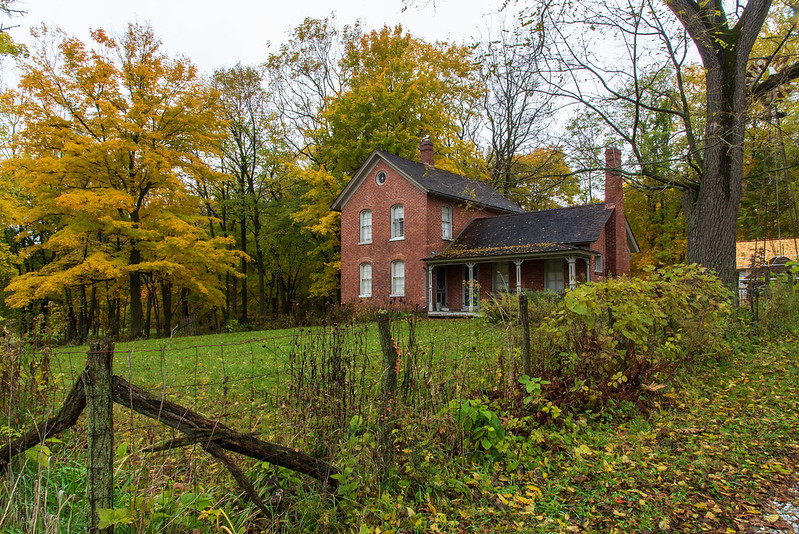 The old farm house wasn't open on this day, but I was still able to wander the grounds. In March, the Maple Sugar Days will be held here, and the kitchen will be filled with the scent of fresh cookies baked on the antique wood stove. For now, I can only imagine how many children played on that porch and in the field in front of the house.
The old farm house wasn't open on this day, but I was still able to wander the grounds. In March, the Maple Sugar Days will be held here, and the kitchen will be filled with the scent of fresh cookies baked on the antique wood stove. For now, I can only imagine how many children played on that porch and in the field in front of the house.  Behind the farm house and barn, lies the colorful sugarbush, the maple tree - filled woods bursting in color at this time of year.
Behind the farm house and barn, lies the colorful sugarbush, the maple tree - filled woods bursting in color at this time of year.
Nestled in the Woods

A hike through the woods of the Bailey Homestead on a cloudy, Fall morning brought us to a few small log cabins. Similar cabins were used in this area for trappers, and even homesteads. Set against the colorful Fall colors, the cabins stand out quite well.
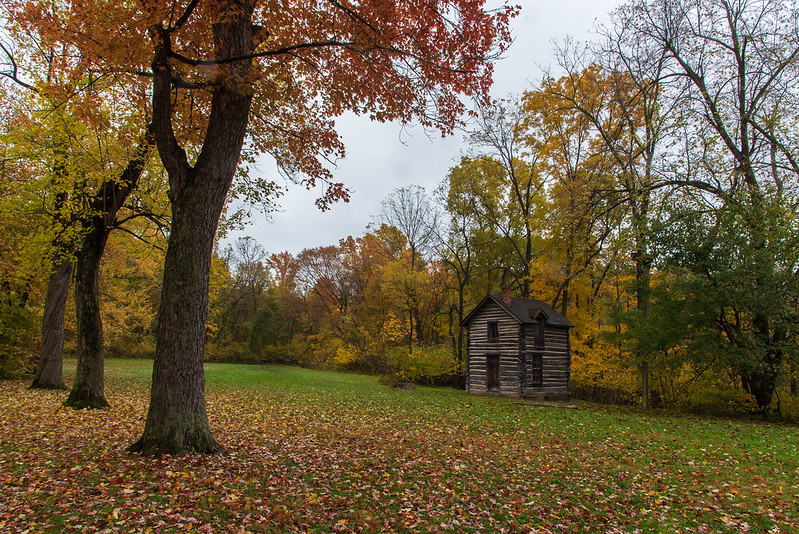
At certain times of the year, these cabins are open to the public for historical demonstrations of the homestead. This particular cabin was used to demonstrate traditional music and dance, while the cabin below is a trapper's cabin complete with tools of the trade and furs.

This area is only about a half mile down the trail from the golden leaves of the Chellberg Farm's sugar bush, making this area very easy to visit while at the farm.
The Sugar Shack in Autumn

One of the staple features of the Chellberg Farm in Spring, the sugar shack rests atop a hill surrounded by Fall color. The maple trees which provide sap for the maple sugar process turn a vivid gold at this time of year, and create one of the most impressive displays of autumn color at the Indiana Dunes National Park.
There are many other areas within the park with beautiful Fall color, but this area is in my opinion the most spectacular. Hiking the trails through the sugar bush, one is surrounded by the golden leaves not only on the trees, but on the forest floor.

Subscribe to:
Comments (Atom)

